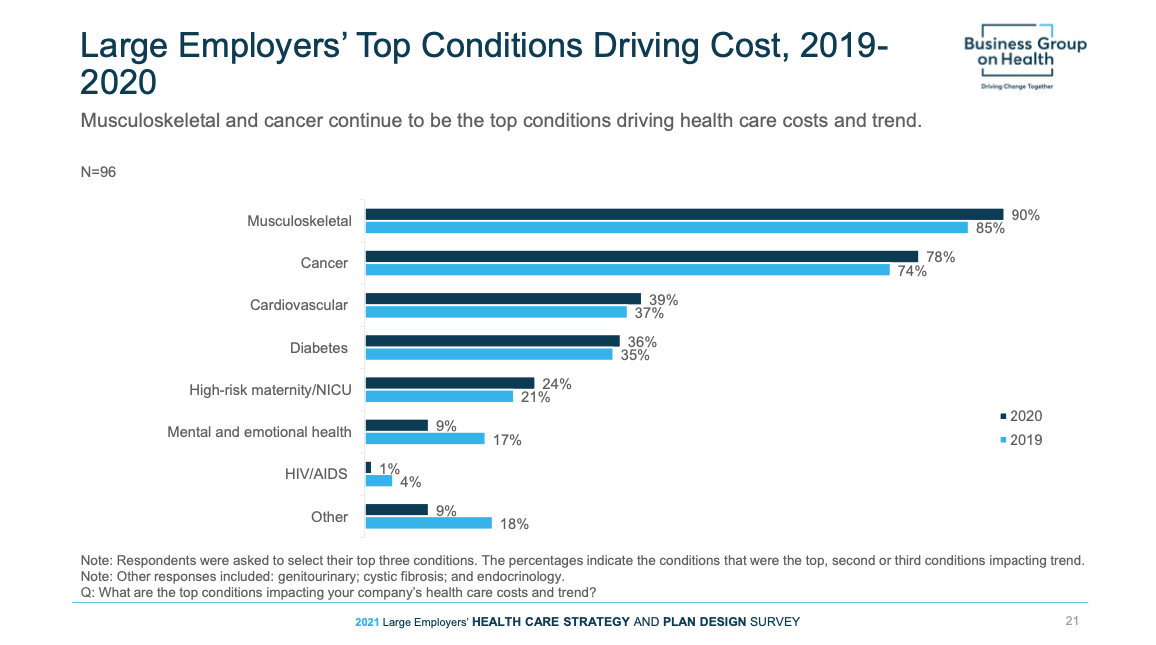The COVID-19 pandemic upended employee benefits strategies almost as soon as it began. With 2021 planning underway, are increases in telehealth and mental health support sticking around?
The Business Group on Health set out to answer that question. In their 2020 report, some areas of focus, particularly telemedicine and mental health, saw significant spikes in interest that can be attributed in part to the pandemic. The data also suggests that companies are interested in tackling traditional challenges, such as lowering high-cost claims, through new, digital approaches.
Musculoskeletal pain tops the charts
Musculoskeletal (MSK) pain was a top source of healthcare spending for 90% of employers, up from 85% in 2019.
In response to rising costs, 68% of employers said they predict they will have a corporate musculoskeletal program in place by 2023.

Of the survey respondents, 53% said they plan to invest more in virtual care in 2021. Taken together, interest in musculoskeletal pain programs and telehealth suggests that employers are recognizing that musculoskeletal pain in particular can be addressed more effectively through virtual solutions.
Ellen Kelsay, president and CEO of the Business Group on Health, agrees.
“We also see that virtual solutions are sometimes more effective in many ways, such as for musculoskeletal treatments,” Kelsay told AJMC. “Many people used to go see surgeons when they had back and spine issues, and we know that most of many musculoskeletal issues can be effectively addressed, at least in the early stages, via physical therapy, and that in some instances physical therapy can be delivered effectively through a virtual solution.”
Effective care delivery at the right time can make a significant difference in pain outcomes, as well. Virtual programs give people in pain the opportunity to access appropriate care without leaving home. Through a virtual program like Fern, people in pain also have access to multi-modal treatment that addresses the psychological side of pain in one place.
In general, 80% of those surveyed predict that telehealth will play a significant role in how healthcare is delivered in the future – up from 64% in 2019 and 52% in 2018.
Employers double down on mental health
In addition to implementing virtual solutions, more than a third are going to expand access to mental health services.
Year over year, large employers have expanded their mental health offerings. In 2019, 58% of employers provided mental health-related online resources. Going into 2021, 88% plan to provide such online resources.
Another significant jump: In 2019, 30% provided manager training on recognizing mental health issues and directing employees to appropriate services. For 2021, 65% plan to offer manager training for mental health.
Mental health and musculoskeletal pain are closely connected. Chronic pain and depression occur together 30 to 50% of the time. When together, they raise healthcare costs by 79%. Fern uses pain neuroscience education to address the comorbidities between depression, anxiety, and pain, and to address the underlying cause of pain, which often has a psychological component.
Launching a digital musculoskeletal pain program at your company
Even for those who are working in person, more than 40% total Americans have been avoiding care because of the pandemic. Chronic MSK pain programs are also a helpful option for companies that have on-site clinics at some of their locations, but not all. Physical therapy is expensive and time consuming. Digital programs are convenient for employees no matter where they’re located.
Ready to join the 68% of employers planning to implement a chronic musculoskeletal pain program soon? Get in touch with our team using the form below, and we’ll set up your personalized demo.






